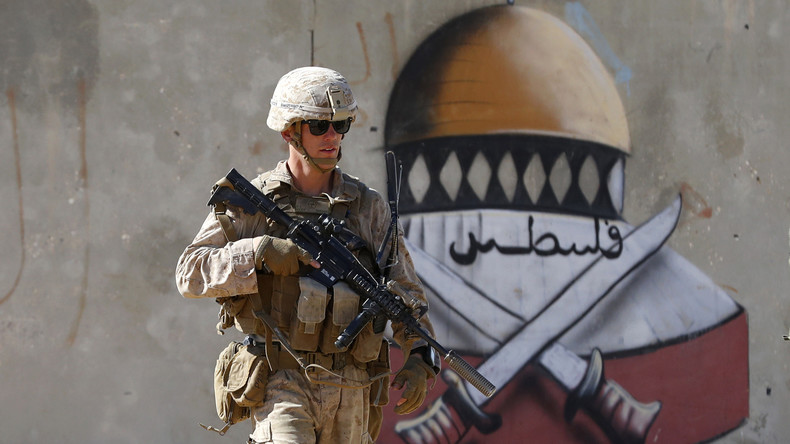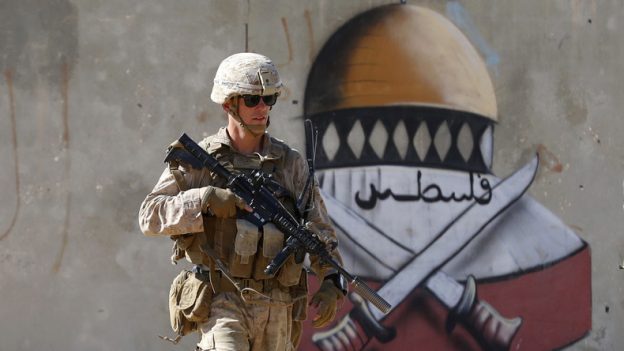Finanzmarkt- und Konzernmacht-Zeitalter der Plutokratie unterstützt von der Mediakratie in den Lobbykraturen der Geld-regiert-Regierungen in Europa, Innsbruck am 03.10.2018
Liebe® Blogleser_in,
Bewusstheit, Liebe und Friede sei mit uns allen und ein gesundes sinnerfülltes Leben wünsch ich ebenfalls.
Aus dieser Quelle zur weiteren Verbreitung entnommen: https://deutsch.rt.com/der-nahe-osten/76963-neue-us-dokumente-zeigen-demokratie-nie-ziel-in-syrien/
Neue US-Dokumente zeigen: Demokratie war nie das Ziel in Syrien

Der in London lebende investigative Journalist Dr. Nafeez Ahmed hat ein enorm wichtiges Dokument aus dem riesigen WikiLeaks-Fundus ausgegraben. Ein Strategiepapier des United States Marine Corps (USMC) Intelligence Department, dem Militärnachrichtendienst des Marine Corps und Teil des übergeordneten Militärgeheimdienstes DIA, hat nur wenige Monate nach Ausbruch der Proteste in Syrien eine Einschätzung der Lage abgegeben. Darin heißt es, dass Assads Regierung „in den nächsten drei Jahren signifikant geschwächt wird, aber der drohende Zusammenbruch erscheint unwahrscheinlich“.
Der Grund für diese Einschätzung lag darin, dass die „zersplitterten Oppositionskräfte in Syrien (vermutlich) die logistische Hürde nicht überwinden können, die sie davon abhält, eine Einheit zu werden und so innerhalb dieses Zeitrahmens eine ernstzunehmende Bedrohung für das Regime darzustellen“. Zwar wäre ein Regimewechsel durchaus erstrebenswert, aber in der Praxis kaum umsetzbar. Ein solcher Versuch würde nur zu „einem gewalttätigen, langwierigen zivilen Konflikt führen, der sektiererische Unruhen entzünden würde“. Zwar könne man „das Potenzial für einen Zusammenbruch des Regimes nicht ausschließen, aber der Weg zum Regimewechsel wird ein langer und blutiger sein“.
Um Assad aber trotzdem irgendwie vom Thron zu stoßen, sah das Dokument vor, so großen Druck auf die herrschende Minderheit der Alawiten aufzubauen, dass sie selbst den Sturz des Präsidenten initiieren. Und der Druck auf die Alawiten sollte in Form von „Ausbildung von Oppositionskräften“ entstehen, die von Sondereinheiten der USA, Großbritanniens, Frankreichs, Jordaniens und der Türkei ausgebildet werden sollen. Damit sollte die im Westen als demokratische Phalanx beschriebene Opposition nach den Plänen der USA nichts weiter als ein Mittel zum Zweck werden und ganz sicher keine ernstzunehmende oder gar demokratische Alternative für Assad.
Das übergeordnete, geostrategische Ziel dieses ganzen Plans hatte sehr wenig mit Syrien selbst zu tun. Denn was aus den Dokumenten ganz klar hervorgeht, ist die Sorge der US-Amerikaner, ihren Einfluss auf die Länder des Nahen Ostens zu verlieren, sobald sie ihre Truppen aus dem Irak abziehen. Dieses Machtvakuum werde sofort vom Iran ausgefüllt werden, um den eigenen Einflussbereich bis zum Mittelmeer auszudehnen und die eigene Grenze zum Irak abzusichern, sodass es keine Angriffe durch eine Art neuen Saddam Hussein geben könne. Aber um diese iranische Einflussnahme zu verhindern, nahmen die US-Strategen in Kauf, dass die syrische Opposition von radikalen Islamisten und Extremisten unterwandert und am Ende marginalisiert wird.
(Die) Türkei, die Vereinigten Staaten, Saudi-Arabien, Ägypten und andere haben ein gemeinsames Interesse daran, zu versuchen, die Position des Iran in der Levante gravierend zu schwächen und den politischen und militärischen Einfluss der Hisbollah im Libanon zurückzudrängen. Insbesondere die Türkei ist das Land mit dem langfristig größten Einfluss auf Syrien, und sie hat ein Interesse daran, dass dieses Territorium wieder unter sunnitische Herrschaft kommt.
Das Perfide daran ist, dass den Planern in Washington zu diesem Zeitpunkt bereits bewusst war, dass der Türkei die eigentlichen Mittel für den „langfristig größten Einfluss“ fehlen. Um dieses Problem zu lösen, würde die Türkei „allmählich versuchen. Verbindungen zu Gruppen innerhalb Syriens aufzubauen, mit Fokus insbesondere auf die Überreste der islamistischen Muslimbruderschaft, um eine funktionsfähige islamistische Politmacht aufzustellen, die unter dem Schirm von Ankara steht“.
Die Türkei sollte sich also für die USA die Hände schmutzig machen, während das Marine Corps, eine Teilstreitkraft der gesamten US-Streitkräfte mit über 200.000 aktiven Soldaten, sich nicht in den Krieg in Syrien einbringen wollte:
Wir erwarten nicht, dass das USMC militärisch in Syrien oder im Libanon mit einer Mission intervenieren wird, um die Situation zu stabilisieren. Die sektiererische Dynamik ist viel zu komplex für die Vereinigten Staaten, als dass es sich lohnen würde, darin verwickelt zu werden. Stattdessen wird das eine regionale Krise sein, um die sich die Türkei kümmern wird. Während sich die Türkei noch früh in ihrem regionalen Aufstieg befindet, wird sie beachtliche Unterstützung und Hilfe ihrer Alliierten benötigen.
Und der Lohn dafür würde die türkische Einflussnahme – oder sogar Besatzung – von Gebieten in Syrien sein, die die moderne und willkürliche Grenzziehung der Briten in der Region wieder zurückdränge. Zu diesem Schluss kam auf jeden Fall Dr. Roby Barrett, der an der Joint Special Operations University in Florida lehrt. Er sah eine Fragmentierung der Länder wie Syrien, dem Irak und Saudi-Arabien entlang der ethnischen und religiösen Linien voraus. Selbst als Russland 2015 in das Geschehen eingriff, dachte Dr. Barrett, dass das im Höchstfall für die Sicherstellung eines „Alawitestan“ reichen würde.
Was bei den US-Strategen aber offensichtlich völlig unterschätzt wurde, war die hohe Unterstützung der syrischen Gesellschaft für Assad. Ohne diesen Rückhalt in der Bevölkerung wäre der syrische Präsident trotz Hilfe von außen nicht in der Lage gewesen, den im Westen geschmiedeten Plänen sieben Jahre Widerstand zu leisten.
Mehr zum Thema – Textilunternehmer aus Aleppo im Gespräch mit RT: „Westliche Regierungen haben Terroristen geschickt“
Aus dieser Quelle zur weiteren Verbreitung entnommen: https://mondediplo.com/outside-in/syria-democracy-documents
US military document reveals how the West opposed a democratic Syria

US military documents from 2011 and 2016 reveal that although officials wanted a Syrian regime change in theory, they thought it was highly unlikely to actually happen — and hoped that if President Bashar al-Assad was overthrown, he would not be replaced by an opposition-led Syrian democracy but, rather, the same Alawite-Baathist ruling structure would continue. The end result was to be the decimation of the democratic opposition, the consolidation of Islamist forces and regime preservation.
‘The US has given up on the overthrow of Assad in Syria’, wroteRobert Fisk this summer. Indeed, as the Russian-backed Syrian army prepared to execute its final offensive on Idlib, western governments appeared to signal their acceptance of a bloody victory for Assad, despite the ritual denunciations.
But at the last minute, Russia and Turkey agreed a truce to ward off a Russian-led attack for at least a month, and establish a buffer zone to protect 3 million civilians. The deal will involve hashing out how to remove extremist rebels from the buffer zone, and Turkey has announced it will send more troops into Idlib.
As the Idlib offensive loomed, the West, curiously, did little of substance in any particular direction. According to two newly uncovered US military documents, western reticence might be because the US was never really committed to overthrowing Assad, due to a self-serving strategy that has been wildly misunderstood.
The documents suggest that both early on and toward the later phase of the conflict, senior US military officials had not given any credence to the democratic aspirations of Syrian protestors, but had merely sought to use them as a tool to sideline expanding Iranian influence. Toppling the regime was dismissed as a highly improbable scenario, with officials indicating they believed the survival of an authoritarian Baathist governing structure — with or without Assad — was inevitable.
Predicting opposition failure
According to a US secret draft military document obtained via the Wikileaks archive, as far back as August 2011 (six months after the Syrian uprising began) US military officials were highly ambivalent about ‘regime change’ in Syria, on the grounds that opposition forces would never win. Supporting the rebels, the officials hoped, might encourage forces within Assad’s regime to remove him while maintaining the Alawite-dominated authoritarian power structure. But military intervention was not on the cards.
The document, reported here for the first time, is the draft of an internal US Marine Corps’ (USMC) Intelligence Department forecasting paper, produced jointly by analysts at the private intelligence firm Stratfor and senior USMC officials (1).
‘The Syrian Alawite-Baathist regime led by President Bashar al Assad will weaken significantly over the next three years, but its break point is unlikely to be imminent’, it states. ‘Fractured opposition forces in Syria are unlikely to overcome the logistical constraints preventing them from cohering into a meaningful threat against the regime within this time frame.’
The document was meant to be an internal USMC intelligence assessment and was never formally released to the public by the agency. It saw regime change as desirable in theory, but unattainable in practice, warning that Syria would experience ‘a violent, protracted civil conflict, one that will enflame sectarian unrest… The potential for the regime to collapse cannot be ruled out, but the road to regime change will be a long and bloody one.’
While the document does not strictly rule out regime change, it marshals abundant evidence to argue that a regime change effort would be futile. In particular, the document concludes that opposition forces would be unable to overthrow Assad: ‘… the opposition in Syria does not yet have the numbers, organization or capabilities overall to overwhelm the regime forces. Syria’s opposition is extremely fractured and is operating under enormous constraints inside the country.’
Hoping the Alawite elite steps in
Instead, the USMC report states: ‘The more probable threat the regime will be facing will come from within’ — in the form of ‘an attempt by high-ranking military and business elite of the regime to mount a coup’ against Assad, prompted by fears of his weakness.
The document puts into context previously reported leaked Stratfor emails dated from December 2011 (four months after the USMC draft document), referring to a write-up of a meeting with US military intelligence officials. The write-up ruled out a major air campaign and noted the role of special operations teams on the ground in Syria ‘training opposition forces’ to ‘try to break the back of the Alawite forces, elicit collapse from within’.
Taken in context with the USMC Intelligence Department’s draft forecasting document from August 2011, it is clear that senior US defence strategists did not envisage a democratic victory for the opposition, but hoped to create sufficient pressure to usher in a collapse of the ‘Alawite forces … from within’, by triggering an Alawite coup against Assad. In other words, the opposition was seen as a temporary tool, to be discarded once the goal of ensuring a more ‘friendly’ autocratic Baathist structure was in place.
The draft USMC intelligence document notes that despite a growing appetite among US allies for an alternative to Assad, no one wanted to actually get their hands dirty trying to topple him.
Conceding that ‘external support for a Syrian alternative to the al-Assad regime will grow with time,’ the document observes that ‘none of the major stakeholders in the region, including Israel, Turkey, Saudi Arabia and the United States, appear interested in dealing with the destabilising effects of regime change in Syria in the region.’
Prepared in August 2011 as part of a series of USMC intelligence briefs drafted with Stratfor’s support, the document was buried amidst the massive corpus of Stratfor emails that were originally leaked and published by Wikileaks from 2012 to 2014.
Within the 5 million strong Stratfor corpus is a body of email correspondence in 2011 between Stratfor analysts and senior US Marine Corps officers. The emails show that the USMC Intelligence Department had commissioned Stratfor to work with USMC officials in drafting this intelligence forecasting paper, along with several other briefs. The USMC officials who established the Stratfor partnership included USMC chief of intelligence assessments Lieutenant Colonel Drew Cukor, Major William Osborne of USMC’s Future Assessments Branch, and USMC Director of Intelligence, Brigadier General Vincent Stewart.
Some caveats: the document is only a draft and we cannot tell what the final polished version looks like, although the USMC-Stratfor drafting process can actually be traced through the leaked correspondence — and this document looks to be a near final version. Also, the document is obviously not a direct reflection of US government policy, but rather gives us an insight into the internal assessment of senior US military intelligence officers. In that sense, while the document’s import should not be automatically conflated with White House policy, we ought not to dismiss its significance in granting insight into how US military planners appear to have viewed the conflict from early on.
While the document does not explicitly make direct policy recommendations, it sets out available options, preferences and scenarios. The USMC Intelligence Department, for which the forecasting assessment was drafted, is a highly influential agency which directly feeds into the execution of special operations. According to its mission statement: ‘The Intelligence Department is responsible for policy, plans, programming, budgets, and staff supervision of Intelligence and supporting activities within the Unites States Marine Corps. The Department supports the Commandant of the Marine Corps (CMC) in his role as a member of the Joint Chiefs of Staff (JCS), represents the service in Joint and Intelligence Community matters, and exercises supervision over the Marine Corps Intelligence Activity (MCIA).’
This makes it all the more significant that the draft USMC intelligence assessment concluded that it was highly improbable that the regime would collapse.
Support for Sunni Islamists to undermine Shia Iran
US military officials’ biggest fear was the prospect of Iran expanding its geopolitical influence. The document advocated that the US work with its regional allies in supporting Islamist groups to counter this: ‘… Turkey, the United States, Saudi Arabia, Egypt and others have a common interest in trying to severely undermine Iran’s foothold in the Levant and dial back Hezbollah’s political and military influence in Lebanon. Turkey, in particular, is the country with the most leverage over Syria in the long term, and has an interest in seeing this territory return to Sunni rule.’
Despite acknowledging that opposition groups would probably fail to overthrow Assad, the document still assesses that they could be mobilised to counter Iranian encroachment. It was accepted that this would empower Islamist forces among the Syrian opposition, rather than democratic and secular forces: ‘Turkey does not have good options nor the capability to effect change in Syria any time soon, but it will gradually attempt to build up linkages with groups inside Syria, focusing in particular on the Islamist remnants of the Muslim Brotherhood in trying to fashion a viable Islamist political force in Syria that would operate under Ankara’s umbrella. This will take time to develop, but the geopolitical dynamic of the region points to a gradually [sic] weakening of the Alawite hold on power in Syria.’
The anti-democratic nature of the strategy was clear. Regardless of the democratic aspirations driving the Syrian uprising, US military officials were content with the idea of encouraging foreign powers to nurture Islamist forces in Syria who would operate under the ‘umbrella’ of those foreign powers: all to try and weaken Iran’s foothold.
The document also indicates that the US did not plan a military intervention for regime change at this time. The overall verdict was ‘better the devil you know’. ‘We do not anticipate the USMC militarily intervening in either Syria or Lebanon with a mission to stabilize the situation’, the document says: ‘The sectarian dynamics are far too complex for the United States to afford becoming embroiled in. Instead, this will be a regional crisis for Turkey to manage. Since Turkey is still early in its regional rise, it will need considerable backing and support from its allies, but even then, is unlikely to be able to effectively deal with such a crisis within the next three years.’
Breaking up Syria
The draft USMC assessment is largely corroborated by a little-known Joint Special Operations University (JSOU) study published five years later, unreported until now, which similarly provides a window into the thinking of US defence planners.
By 2016, the conflict had seemingly reached a grinding stalemate. The previous year, then Pentagon intelligence chief Lieutenant General Vincent Stewart expected Syria to eventually split into ‘two or three parts’. UN special envoy for Syria, Staffan de Mistura, similarly observed that Syria was experiencing a de facto partition that might need to be formally accepted by the international community. Russia and Iran were moving along the same lines. An international consensus had emerged that Assad would remain in power in an Alawite-run mini-state, leaving the rest of Syria in the hands of ISIS, other Islamist rebels, and the Kurds.
The JSOU study, titled The Collapse of Iraq and Syria: The End of the Colonial Construct in the Greater Levant, was authored by Dr Roby Barrett — a senior fellow at the JSOU where he has instructed US military officers in applied intelligence and advises the Pentagon, State Department and intelligence community. The JSOU is US Special Operations Command’s designated agency to educate and advise Special Operations officers, based at MacDill Air Force base in Florida.
Barrett’s basic message confirms: ‘The solution to the chaos cannot be found in regime change in Syria (although that might help)… The old colonial paradigm of artificial states has been replaced by a new structure that reflects a time that predates the Ottoman’s imperial control. Iraq and Syria no longer exist.’
This meant that US Special Forces (SOF) would need to accommodate a ‘new reality’: a shrunken Alawite regime in Syria, surrounded by a patchwork of opposition groups dominated by Islamist forces. While Barrett’s assessment cannot be taken as automatically reflective of US government policy, it appears broadly consistent with actual policy decisions at the time.
The document suggests that two years ago, US defence strategists were privately content to accept a status quo partition of Syria along ethnic and sectarian lines, with a continued role for both Assad and various Islamist forces: ‘There is already a de facto partition of the Greater Levant into a minority enclave still controlled by the Assad regime in Syria, the increasingly independent Kurdish regions, the emergence of a Sunnistan now dominated by ISIS [Islamic State or IS], and a Shi’a rump state from Baghdad to Basra.’
All this confirms that western goals in Syria were never about supporting the democratic uprising. The key reason the West avoided an all-out regime change strategy was fear of being unable to determine its consequences: ‘In short, the West and its allies wanted the Assads gone, but not the remaining government structure including the Alawite-dominated Syrian army and the security services.’
And Russia’s involvement has ‘at the absolute least assured the survival of an Alawite-rump state in the north and potentially from Damascus to Latakia’ — an observation that clearly underestimated the extent of Assad’s eventual victory.
Ruling out democracy
Barrett explains that the West’s strategy is to continue supporting undemocratic Islamist forces among the Syrian opposition, dismissing any chance of an opposition-based democracy: ‘A secular state run by a group devoted to democracy and western civil society is not going to emerge in Sunnistan. Policy needs to start discarding labels and decide which Islamist Salafi group or groups that it is going to back… to preserve US and Western interests it is going to be a search for the lesser evils.’
His comments reveal how distant US policy planners were from the aspirations of the original grassroots Syrian revolutionaries — exemplified in the Local Coordination Committees (LLCs). The LLCs are a trans-sectarian Syrian youth network which campaigned vigorously for highly participatory forms of direct democracy. But as noted by the Netherlands-based development group, Hivos, the LLCs had been ‘considerably weakened due to repression from both the regime and jihadi groups.’
Rather than support the LLCs, US policy appears to have wavered between weakening and tolerating Assad while largely supporting Islamist groups among the opposition — a strategy whose outcome was to escalate sectarian violence while extinguishing the democratic potential of the 2011 uprising.
To discuss the documents, I met with Professor Nader Hashemi, Director of the Center for Middle East Studies at the University of Denver’s Josef Korbel School of International Studies; and Danny Postel, Assistant Director of Northwestern University’s Middle East and North African Studies Program.
‘With hundreds of agencies in the US government, we should of course be careful about interpreting any internal documents and how they reflect actual US government policy,’ Hashemi told me. ‘But these documents are completely consistent with the real track record of US policy not only in Syria but in the wider region, which has always held a deep and abiding anxiety about any form of democratisation, seeking instead to work with autocratic and authoritarian partners.’
According to Postel, this ambivalence meant that US strategy in Syria was never engaged in a serious effort to remove Assad: ‘If you look closely at what actual US policy in Syria consists of, you can clearly see that the US government has not only consistently avoided regime change, but has in effect pursued a policy of regime preservation.’
The documents confirm that the weakening of the LLCs was a direct consequence of a self-serving US strategy. The idea was to manipulate the opposition to achieve a new authoritarian status quo that would suit western interests, whether dominated by Baathists or Islamists.
Anand Gopal, who has reported from inside Syria, has previously argued that while the US hoped Assad would exit the scene, his continued rule was considered preferable to a democratic revolution. ‘Since the beginning, the US has sought to control the Syrian revolution and civil war to ensure that there would be no outcome directly opposed to American interests’, he said. ‘A successful revolution in Syria — especially one outside of American control — would have profound effects across the region, including in American client states. So although the US doesn’t like Assad and would like to see him step down, it prefers the continuation of Assad’s regime to any potential revolutionary alternative from below. It would like, in other words, a Yemen-type solution to the Syrian crisis.’
So the West’s current policy in Syria is no surprise. Trump’s decision to keep US troops in Syria until Iranian forces depart is consistent with the motivations that drove military officials under the previous Obama administration in Syria. That narrow-thinking led officials to greenlight Turkey’s support to Sunni Islamist groups back in 2011, regardless of the impact on the democratic core of Syria’s opposition; and the same narrow-thinking explains the decision to accommodate a fragmented, Assad-dominated Syria today, while still exerting pressure to sideline Iran’s influence.
No wonder, then, that as the Syrian army amassed its forces in preparation for the Idlib offensive, the West pretty much abandoned the opposition — Islamists, jihadists, beleaguered democrats and Syrian civilians — leaving Turkey to decide how it would clean up the mess.
Nafeez Mosaddeq Ahmed
Support LMD
(1) The paper was attached to an internal Straftor email communication (dated 21 September 2011) within the Wikileaks archive.
——————————————————————————————————–
Aus dem per ÖVP-Amtsmissbräuche offenkundig verfassungswidrig agrar-ausgeraubten Tirol, vom friedlichen Widerstand, Klaus Schreiner
Don´t be part of the problem! Be part of the solution. Sei dabei! Gemeinsam sind wir stark und verändern unsere Welt! Wir sind die 99 %!
“Wer behauptet, man braucht keine Privatsphäre, weil man nichts zu verbergen hat, kann gleich sagen man braucht keine Redefreiheit weil man nichts zu sagen hat.“ Edward Snowden


Hier noch eine kurzes Video zur Erklärung der Grafik Gewaltspirale der US-Kriege
https://www.youtube.com/watch?v=1PnxD9Z7DBs
GRUNDLAGENWERKE zu 09/11 – die ein Aufwachen garantieren:



David Ray Griffin / Daniele Ganser
Der mysteriöse Einsturz von World Trade Center 7:
Warum der offizielle Abschlußbericht zum 11. September unwissenschaftlich und falsch ist
496 Seiten Peace Press, Berlin/Bangkok, 2017ISBN 3-86242-007-8
Bestellmöglichkeiten:- über http://www.peace-press.org oder
oliver.bommer@peace-press.org Euro 29,80 mit Luftpost –
über Amazon Euro 39,80 (inkl. Amazon-Gebühren) mit Luftpost- über jede Buchhandlung Euro 29,80 per Seeweg oder Euro 34,80 per Luftpost
https://www.youtube.com/watch?v=rlLM_TXf2GA



Bitte teile diesen Beitrag:

